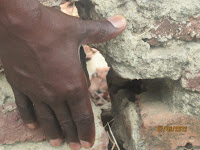 |
| Figure [1] The wall thickness is one and half brickwall, flemish bond, built on black cotton soil.A perpendicular cracks are seen at the face of the walls [Malakal]. |
The cracks may cause undue settlement to the building, making the foundation unstable and the building collapse without taking its expected lifespan.This type of ground is sometimes called Black cotton soil (Vertisols); it is a type of the ground seasonally changing its nature; swelling in wet seasons and shrinking with severe cracks in dry seasons.
Typical examples of these soil are found in Malakal, Upper Nile state and at Juba-Nabari in Central Equatoria state/ Republic of South Sudan.
 |
| Figure 2: Cracks penetrating from the ground, making walls to collapse. |
The the rate of cracks rapidly expands from the foundation of the building and penetrates to the eaves when the roof weigh intensifies as shown is figure 2 are the effects of the unstable ground movement related to the nature of the soil. Those building materials which are used in the construction and yet cracking continue need modification or improvement of skills to minimized the cracks.
My point of departure is “how shall I build safe and durable houses on loose grounds, and what are the types of buildings, materials, and applicable techniques?
My point of departure is “how shall I build safe and durable houses on loose grounds, and what are the types of buildings, materials, and applicable techniques?